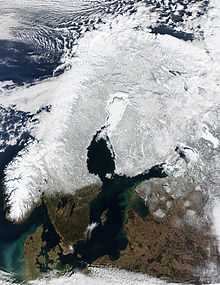Scandinavian defence union
 |
| This article is part of a series on |
| Scandinavia |
|---|
| Geography |
| Viking Age |
|
| Political entities |
| History |
| Other topics |
A Scandinavian defence union between Sweden, Norway, Finland and Denmark was planned after the end of World War II. Finland had fought two wars against the Soviet Union, Denmark and Norway had been occupied by Germany between 1940 and 1945, and Sweden, having been a neutral state throughout the war, had still felt its effects. The four governments agreed that integration in the area of defence was needed, although specific arrangements and the nature of a defence union would be subject to later negotiations.[citation needed]
The position of Finland
Finland had fought two wars, the Winter War and the Continuation War, against the Soviet Union; and also one minor war, the Lapland War, against Nazi Germany. Before these wars Finland had close relations with the Scandinavian countries. After the Continuation War where the Soviet Union forced Finland to sue for peace, but failed in its goal[citation needed] of conquering and annexing the country (in a manner similar to the Baltic States), Finland became neutral and retained democratic government and market economy. However, as the country shared 1,300 kilometres of border with USSR, the position of the Soviet Union could not be ignored in Finnish politics. Regarding the Finnish membership in the Scandinavian defence union, far reaching discussions at state-level were made with the other candidate countries. These discussions were abruptly ended, when Sweden made a specific requirement, that approval from the Soviet Union must be received if Finland was to join. The Soviet answer was bluntly negative and Finland stayed neutral. In 1948, Finland had signed the YYA Treaty with the Soviet Union, and according to the Soviet point of view, this agreement prohibited Finland's membership in any alliances that it could consider being of military nature, even in those created for defensive reasons. Interestingly, the YYA treaty did not stop the Soviet Union from creating the Warsaw Pact in 1955.
Norway and Denmark join NATO
The other three Scandinavian countries would, if they had entered into an alliance, have remained separate sovereign countries but acted as a single bloc in foreign policy and security issues. The proposed union was discussed by a joint Scandinavian committee during the winter of 1948-1949, but the Cold War tensions between the United States and the Soviet Union, and preparations for a western alliance that would result in the North Atlantic Treaty proved that the efforts were in vain. When it became known that the western alliance would not be able to supply the Scandinavian countries with armaments before meeting their own pressing needs, this issue ultimately proved to be the turning point for Norway, which resigned from the talks. Denmark was still willing to enter into an alliance with Sweden, but the Swedes saw few advantages in this and the proposal failed. Norway and Denmark subsequently became signatory parties of the North Atlantic Treaty and members of NATO.
The basis of Swedish neutrality
| History of Scandinavia |
Sweden chose not to join NATO, despite a fierce debate on the issue. One of the strongest proponents was Herbert Tingsten, editor-in-chief of Dagens Nyheter, the largest newspaper in Sweden, who used editorials to argue why Sweden should join. He found a great opponent in the foreign minister of the time Östen Undén, who argued that Sweden should stay non-aligned and remain neutral in case of war. The position of Sweden as a member of the western world was not in doubt, but it could not, based on the choices it had made on foreign policy, join the western military alliance.
Nordic Battlegroup
Whilst not a defence union, the Nordic Battlegroup is a multi-national military unit. It is one of eighteen European Union Battlegroups that support European Union defence and security objectives. It consists of around 2,800 troops from Sweden, Finland and Norway (and with contributions from Ireland and Estonia.
See also
- Military of Finland
- Military of Norway
- Military of Sweden
- Scandinavism
- Swedish neutrality